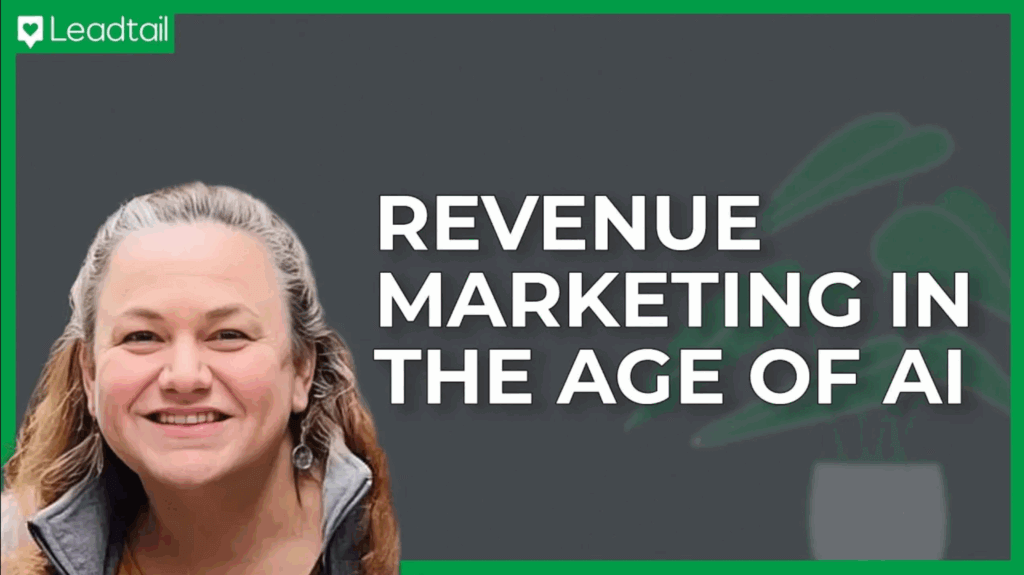The role of a B2B marketing leader has fundamentally changed. The old playbook, which prioritized generating a high volume of MQLs, is no longer sufficient in a world that demands efficient, profitable growth.
In our most recent Leadtail Spirited Conversations episode, revenue marketing expert Nicole Siegal Fuselier, who has a wealth of experience at companies like Cisco and Adobe, outlined a new, more strategic approach.
Nicole argues that marketing leaders, particularly CMOs, must stop chasing MQLs and instead embrace a new superpower: owning the pipeline. This shift is not just about a change in tactics; it’s a complete re-evaluation of how marketing, sales, and product teams align to drive revenue.
The Old Playbook is Broken
Nicole believes that the traditional B2B marketing approach doesn’t work anymore.
The old playbook was centered on volume—creating gated content and scoring on the sheer number of leads. This approach, she argues, goes against the very principle of efficient, profitable growth.
The problem with chasing MQLs is that a “lead” might just be someone who filled out a form to get a PDF, not a genuine prospect ready to buy.
This results in a high volume of low-quality leads, which can waste the sales team’s time and resources. Meanwhile, the C-suite is increasingly demanding to see pipeline contribution, customer acquisition cost, and payback to revenue from marketing.
In this new reality, marketing and sales must be tightly aligned to grow revenue together, not operate in silos. AI can help with this.
AI as a Forcing Function for Change
So, what does this new playbook look like? Nicole outlines several key shifts, all of which are enabled by AI.
- Personalized and Automated BDR Motion: Instead of asking sales teams to chase a high volume of leads, AI can be used to personalize and automate the BDR motion. By using AI to identify quality leads and automate journeys, this frees up the sales team to focus on high-value conversations.
- Intent Data and Persona Research: The era of relying on gated content to get a name and email is over. Nicole points out that AI can provide intent data, allowing you to see which companies are visiting your site and what they’re interested in, without them ever filling out a form. This allows for much more effective persona research and outreach, as you can get a wealth of information about a target account before even making contact.
- Content with Quality and Purpose: While AI can be used for first drafts of content, Nicole warns against the flood of low-quality content it can produce. The real value of content is shifting to quality and the human element, which are more important than ever. For B2B marketers, this means focusing on thought leadership and building trust with your audience.
- Enabling the Sales Team: AI can be used to create enablement journeys for the sales organization. This includes providing scripts and conversation starters based on who the prospect is, helping the sales team move faster and have more impactful conversations.
Measuring What Matters: The Shift to Pipeline and Revenue
Nicole’s process is a new way of thinking. Instead of getting a list of contacts, she now uses AI to get intent data from accounts, identify the right personas, and then create targeted messages and automated journeys for the BDR team.
Her system is built around a key principle: everything given to sales must be a “hand-raise,” meaning the prospect has explicitly signaled their interest in talking to a salesperson.
This focus on quality over quantity extends to how success is measured. Instead of reporting on MQLs and leads,
Nicole argues that we should be reporting on metrics like cost per pipeline, cost per closed-won deal, and customer acquisition cost. She believes marketing’s role is to own the pipeline and the quality of that pipeline, while sales owns the velocity of moving that pipeline to a closed-won deal.
To keep everyone aligned and focused on these new metrics, Nicole shares a powerful example: a weekly scorecard that she sends out every Sunday night to the sales organization and leadership.
This scorecard provides visibility into key metrics like pipeline signals, inbound requests, sales-qualified meetings, and intent data on target accounts.
It also includes a monthly review of “close lost” deals to understand why opportunities were lost, which can provide invaluable insights for product, pricing, and competitive strategy. This scorecard acts as a feedback loop, allowing marketing to understand what’s working and what needs to shift.
A Call to Action for B2B Marketers
The message is clear: the time for change is now. The old playbook of chasing MQLs is no longer effective in a market that demands efficient, profitable growth.
AI is not something to be feared but embraced as a tool to help us work smarter and provide more value to our clients.
By shifting your focus from volume to quality, from leads to pipeline contribution, and from brand to revenue, you can reshape your marketing model and deliver a more impactful, measurable result.
This is an opportunity to be more strategic and partner more effectively with sales. It’s about moving from a world of silos to a unified, full-funnel revenue approach, where everybody wins!
Ready to get started with B2B social media? Let’s talk!
